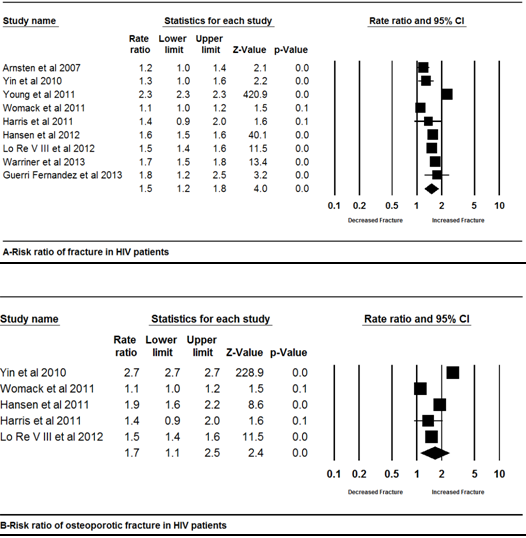Session Information
Session Type: Abstract Submissions (ACR)
Human Immunodeficiency Virus (HIV) infection is associated with development of osteoporosis and decreased bone mineral density. However, studies have been inconclusive in whether this translates to increased fracture incidence. In our study, a meta-analysis of observational studies was performed to examine fracture rate ratio in HIV patients.
Methods:
2 independent researchers systematically searched Pub Med and Embase from earliest available online year of indexing up to March 2013 using Medical Subject Headings terms and key words pertaining to two major themes-HIV and fractures. Abstracts from the Conference on Retroviruses and Opportunistic Infections, the International Acquired Immunodeficiency Syndrome (AIDS) Society Conference on HIV Pathogenesis and Treatment, and the International AIDS Conference were also manually searched. All controlled observational studies that compared fracture incidence in HIV patients with a control group (consisting of uninfected individuals or the general population) were included. Pooled rate ratio was calculated using generic inverse variance weighting and a random effects model.
Results:
Of 2050 identified publications, 9 publications (6 prospective cohort studies and 3 retrospective cohort studies) were eligible for analysis. The analysis included 169544 HIV patients with 2101 incident fractures. The pooled rate ratio for any fracture was 1.5 (95% CI 1.2-1.8), and 1.7 (95% CI 1.1-2.5) for osteoporotic fractures. For site specific fractures, the pooled rate ratio for hip, spine, and wrist/forearm fracture were 2.5 (95% CI 1.3-5.0), 1.5 (95% CI 0.8-3.0), 1.3 (95% CI 0.7-2.4). There was significant heterogeneity present among studies for main analyses and subgroup analyses. Subgroup analyses did not show significant differences regarding gender, study design, whether BMI was adjusted, and duration of follow-up. For fractures and osteoporotic fractures, both funnel plots were symmetrical and the Orwin’s Fail-Safe N was 737 and 492 respectively.
Conclusion:
In our meta-analysis of observational studies, HIV infection was associated with increased incidence of fracture, osteoporotic fracture, and hip fracture as compared to uninfected individuals or the general population. Because there was significant heterogeneity present in pooled estimates, and residual confounding cannot be excluded, the results have to be interpreted with caution. However, clinicians need to be aware that HIV patients may be at increased risk for fractures. Therefore, appropriate evaluation and treatment is required, especially in HIV patients with other risk factors for osteoporosis. As the HIV population ages, it is important to evaluate the timing of screening and the individual contributions of HIV, antiretroviral therapy, and traditional risk factors in the development of osteoporosis and fractures in HIV patients.
Disclosure:
S. Y. Lim,
None;
A. M. Rivas,
None;
K. Nugent,
None.
« Back to 2013 ACR/ARHP Annual Meeting
ACR Meeting Abstracts - https://acrabstracts.org/abstract/human-immunodeficiency-virus-infection-and-fracture-risk-a-meta-analysis/

